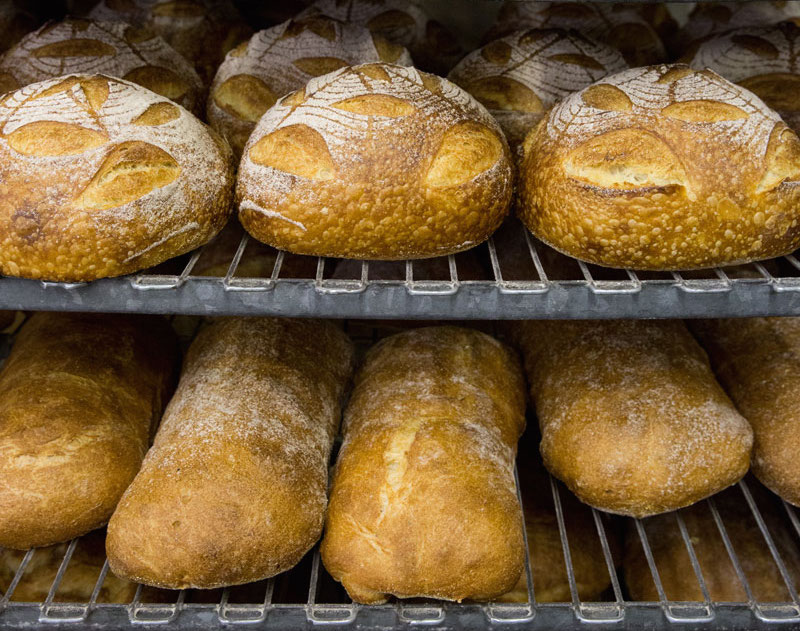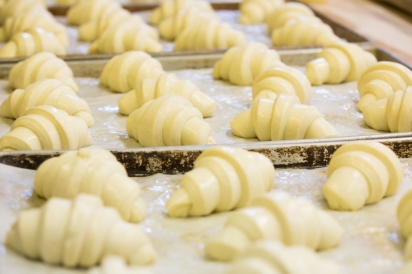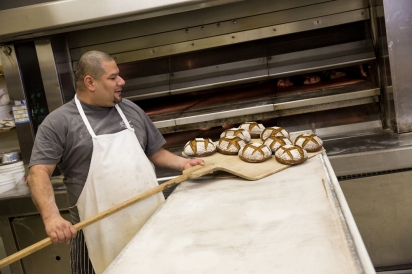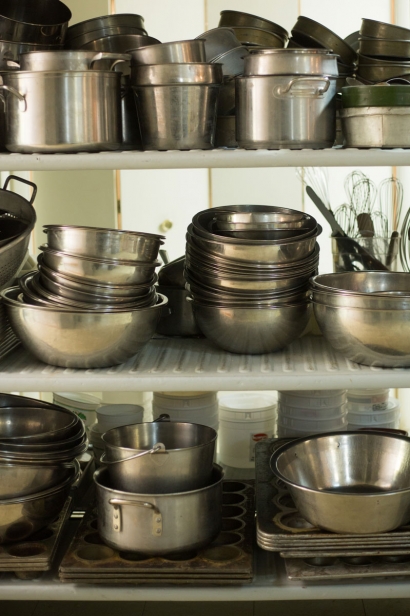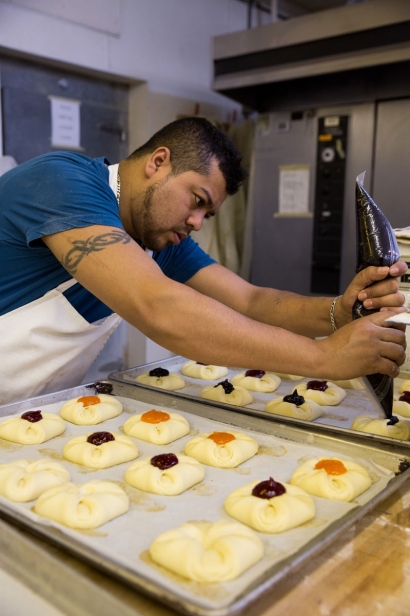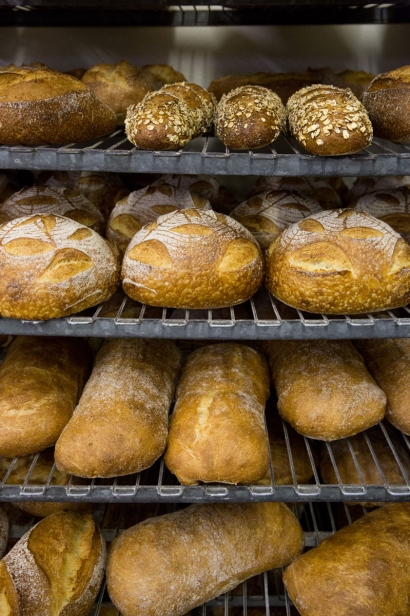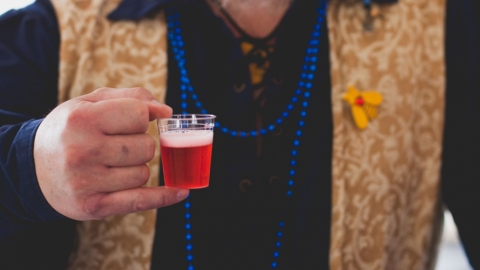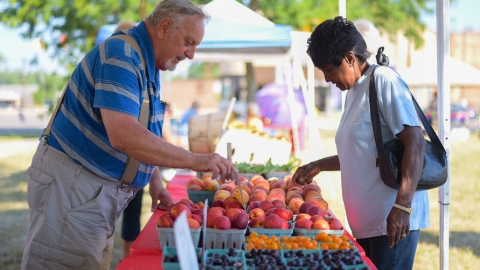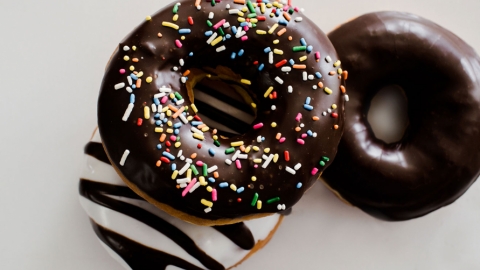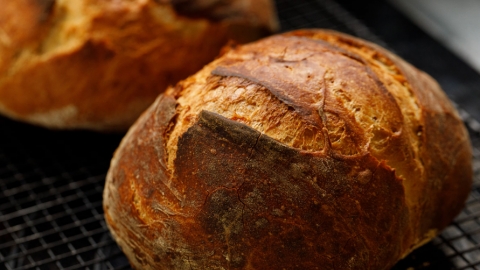Overnight in a Bakery
Without the bakers’ precisely timed and executed dance each night, all the specialized equipment and ovens are useless.
Seven nights a week, skilled bakers at the award-winning Bit of Swiss Artisanal Bakery produce scratch-baked items for Michiana residents to enjoy the next day. Their elegant, decadent and downright delightful croissants, Danish, scones, muffins, coffee cakes, cinnamon bread and cinnamon rolls are a sweet part of each night’s 10-hour production-baking shift in two brightly lit work areas.
The process that brings them to life is amazing. It’s all in the hands. Mostly flour covered. Always working. They touch each item as they bake through the night.
Work is planned and calculated precisely.
Overnight baking meets the next day’s specific retail and wholesale needs. But overall, the bakers’ nightly timeline (see below) is basically the same each day.
While we eat dinner, they pull the next day’s pre-shaped croissants and Danish from the cooler to proof. When we think about heading to bed, they, not even halfway through their work, bake coffee cakes. As we dream through early morning hours, they busily ice pastries. Long before most of us awake, they scale mixes for tomorrow’s day crew.
Friday is the busiest night.
Bit of Swiss employs only six bakers (and one always-busy dishwasher) to accomplish everything. The bakers’ combined experience totals more than half a century. Amid their easy banter and the constant waves of ventilation system roar and dishwasher din, they bake racks of Danish and loaves in one oven and the next day’s miches and free-form breads and rolls in another massive, recessed, wall-size oven. They demonstrate a bone-deep understanding of their work. One casually flings flour to dust dough and work surfaces. Others quickly scale ingredients, knead and hand-shape loaves or mix poolishes so tomorrow’s staff can prepare the next night’s ready-to-bake breakfast pastries. The night’s particular workflow permits brief, opportunistic breaks, rather than ones based on the clock.
Motion never ceases.
As each baker finishes one task, he glides into the next. One moves from working in the front room to the back. One shifts from manning the oversize oven to shaping loaves at a bench. Another finishes racking oven-fresh, aromatic baked goods, turning to fill the next batch of pastries. Although a head baker is present, there seems to be little direction. Rather it appears that each person’s intuitive knowledge of the night’s overall workflow and techniques allows him to move effortlessly from role to role. Like well-choreographed dancers, each baker knows exactly where the others will be and trusts their teammates to do their part. Their fluid progress demonstrates clearly why they, the bakers, are the bakery’s most efficient and effective technology. Without the bakers’ precisely timed and executed nightly dance, all the specialized equipment and ovens are useless.
Production changes seasonally.
This Friday’s production calls for only 764 breakfast items, down significantly from the previous Friday, now that the last farmers markets have closed. November schedules briefly add the bakery’s signature Wild Rice Bread. December nights find bakers producing Christmas stollen, an item deeply woven into multiple generations’ breakfast memories. Between Easter and Labor Day, the area’s increased second-homeowner population and reopened farmers markets swell demand again. The finite numbers of bakers and overnight hours somehow produce inevitably increased “high season” needs.
Dawn approaches.
The number of clean pans, tubs and bowls starts to surpass ones yet to be washed. Ovens cool. The mixer quiets and is cleaned. In pre-dawn peacefulness, after using nearly 500 pounds of flour, the crew goes home in a largely still-slumbering world. Bakers sleep through the day and see their families and friends on days off or briefly the afternoon of their next overnight in the bakery.
No Loafing:
Nonstop Baking Through the Night
The team’s working relationship enables it to consistently complete nightly and seasonally changing baking needs. When I asked for a baking schedule for the night I observed, I was told no detailed plan like this had ever been written down before. The bakers have worked together so long they understand the nuanced requirements by looking at what needs to be produced, or they talk through it on the fly. However they do it, they get everything done, almost magically.
Bread Bakers' Timeline
Vinny Casciotta (pictured below), the Bit of Swiss night crew’s number-one baker, prepared this timeline. With his 20+ years of experience, it is a clear path through the night. Most descriptions contain multiple steps for the bakers. See the glossary below for definitions of baking terminology.
Pull all yeast-raised dough—croissants and Danish. Mix sourdough levain. Mix focaccia. Proof croissants and Danish.
Mix rye bread. Mix como poolish for next day, mix second feed for miche bread. Scale como.
Bake miche, paesano and sourdough. Spray pans. Prep to bake breakfast pastries, prep muffin mix batter with blueberries and apples.
Mix ciabatta and kaiser rolls. Bake como. Bake breakfast pastries. Scale rye and ciabatta.
Scale kaiser rolls, mix challah. Bake multigrain and paesano pans, mix pretzel dough. Shape and proof rye. Scale pretzels.
Mix Italian. Bake all muffins. Mix golden wheat. Calculate the next day’s preferments and levains. Scale challah.
Bake rye. Make up challah rolls, pans and braids. Mix cheddar bread. Glaze half the breakfast pastries that are baked. Mix multigrain/fruit bâtards.
Mix 100% whole grain bread, bake Danish and croissants. Shape and proof golden wheat. Shape and proof Italian.
Start mixing all levains for next day. Do all seed soakers for multigrain and 100% whole grain. Mix Parmesan rosemary mini bâtards. Mix baguette. Scale cheddar bread. Bake coffee cakes, almond rings and Seven Sisters.
Glaze the rest of pastries. Bake focaccia and ciabatta. Bake golden wheat. Cut Italian into hoagies. Scale 100% whole grain and put in baskets.
Mix poolishes for next day. Mix multigrain. Ice all pastries. Bake pretzels, Kaisers and the rest of the pan breads. Finish all levains.
Mix paesano and sourdough for next day. Finish the rest of poolishes. Bake 100% whole grain bread. Bake challah, pans and braids. Mix miche. Mix rye levain.
Shape Parmesan rosemary and proof. Scale multigrain and paesano. Shape baguettes and epis. Bake Italian. Mix starter. Clean bowls.
Bake epis and Italian sticks.
Scale out dry mixes. Scale miche. Bake baguettes. Shape multigrain, paesano and sourdough. Bake multigrain bâtards.
Shape miche. Clean up. End of shift!
Glossary
Adapted from baking dictionaries on the web.
Como: Bit of Swiss’s version of ciabatta. It has a high water content, which gives it larger holes.
Levain: a type of preferment used in sourdough. See Preferment.
Miche: a bread commonly called “country bread” or “pain de campagne” with ingredients similar to a baguette. It has been served for centuries on French tables.
Poolish: a transitional preferment between sourdough baking and commercial yeast baking. See Preferment.
Preferment: a dough or batter prepared prior to mixing the final dough and composed of a portion of the total formula’s water, yeast and sometimes salt. A natural, traditional technique to improve bread quality.
Proof: the act of letting a yeast dough product rise.
Pull-aparts: a sweet, sticky, gooey cinnamon breakfast pastry consisting of small pieces of soft bread that can be easily pulled apart.
Scale: to weigh or measure ingredients for mixing or dough to ensure consistency.
Seven Sisters: a circular tin of seven cinnamon rolls with the largest in the center and six smaller ones around it.
Bit of Swiss
4333 Ridge Rd.
Stevensville, MI
269.429.1661
bitofswiss.com
@ Martin's Supermarket, various Indiana & Michigan locations


